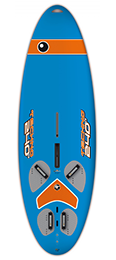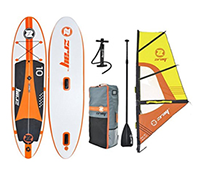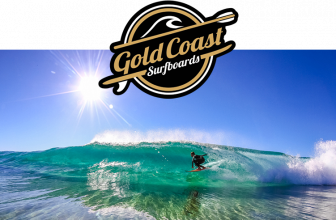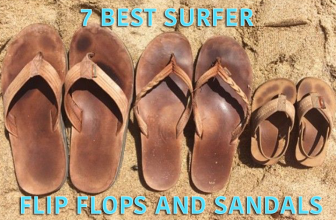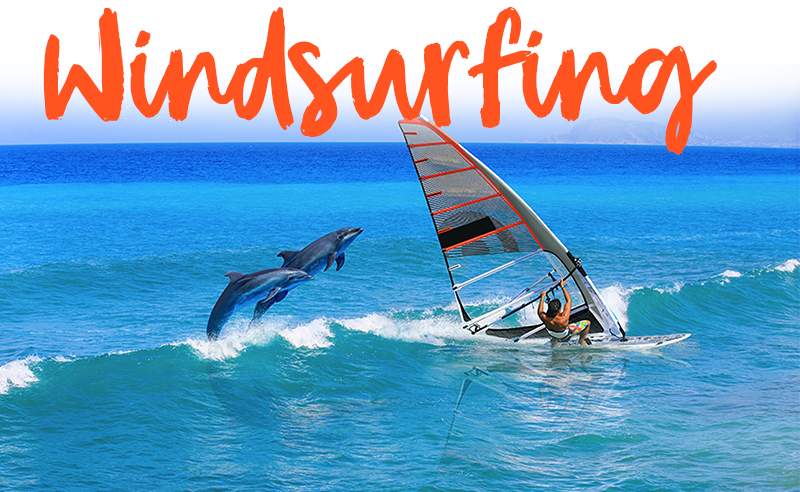
Windsurfing is truly a sport like no other. It’s far from the world of surfing and stand-up paddle boarding, as you use the wind rather than the water.
More...
The beauty is, because you’re on water, you can catch some solid air and create some solid speed with glassy conditions.
There are a wide variety of boards out there for different levels of windsurfers. This can make finding the right one, especially if you’re a beginner, a daunting task.
Even then, it is very important to get a top-quality board that will grow as you do.
Come with us as we dive into some of the best windsurfing boards on the market!
Our Top Recommended Windsurfing Boards
- Kona One One Step One Windsurf Board
- ASA/EVA Construction
- 11.4 Feet Long
- Great for Beginner Windsurfing and SUP Riding
- BIC Techno 240D Windsurf Board
- ACE-TEC Construction
- 9.7 Feet Long
- Great for Fun and Performance
- Z-Ray Windsurfing Inflatable Stand-Up Paddleboard Set
- Durable PVC Construction
- 10 Feet Long
- Great for Fun Performance and SUP Riding
Our Top 5 Picks
Best Inflatable Windsurfing Board
Our #1 Pick – Z-RAY WINDSURFING INFLATABLE STAND-UP PADDLEBOARD SET
Review
Whether you feel like paddling or windsurfing, this versatile board can give you the best of both worlds. At 10 feet long and 30 inches wide, it’s just the right size to give you solid stability without sacrificing performance. The board comes complete with a kit that has many different accessories. The included aluminum paddle is durable and can be used when you feel like paddleboarding. There is also an included hand pump that quickly inflates the board and a cool little backpack that is just big enough to store everything in when you’re done with your session.
The included sail attaches easily and can provide you with tons of maneuverability as you twist and turn through the ocean blue. While it’s an excellent all around board, the transportation aspect really helps it to stand out. If you’re constantly travelling, this is truly the perfect windsurfing apparatus.
Pro's
Con's
Best Intermediate Windsurf Board
OUR #1 PICK - BIC SPORT TECHNO 240D
Review
If you’re an intermediate rider and you’re looking for a board that help you bust some sweet airs and have fun out there in the water, the BIC Sport Techno 240D might be just the board for you. At 9.7 feet long, it’s a bit better for performance and skilled riders. Even beginners won’t have an issue learning how to plane and jibe. The feet straps are excellent because they keep you locked in as you begin to take off. A unique feature of the Techno 240D is the retractable daggerboard. This is perfect for those who want to gather some insane speed when gliding across the blue.
The ACE-TEC construction provides enough volume so that you still feel stable, though at 34lbs, it’s a lot lighter than most boards. Even a small gust of wind will be able to get you going. From the high-quality BIC materials to the solid footsraps to the stability and performance, this board gives you everything you need to greatly improve your windsurfing technique.
Pro's
Con's
Best Beginner Windsurf Board
Our #1 Pick - KONA ONE STEP ONE WINDSURF BOARD
Review
The Kona One Step is the perfect board for beginners. It comes with your basic dagger board, a solid deck pad, and a quality fin. The handling on this board is incredibly smooth and beginners will have an easy time getting the hang of their balance and riding. Because it is so long and narrow, you have the stability, yet can still pick up speed with the wind. It planes up really nicely, letting the nose glide atop the water without much drag.
If you’re a beginner who wants to eventually get up to the racing circuit, this is a perfect board to start with. You can also use it as a SUP when the day is feeling lazy. The unique feature of the Kona One Step is the step-tail design that decreases the planing threshold, allowing you to plane much faster than other boards. With a gorgeous and minimal white design, this board is a great look all around with some awesome features to go with it.
Pro's
Con's
#2 - BIC Sport Techno 293 One Design DTT
Review
The BIC Sport Techno 293 is one of the boards you should look into if you’re serious about windsurfing, as it is top-of-the-line. Perfect for racing, this board is a great choice for export windsurfers. That being said, it also provides tons of stability so you can teach your friends and loved ones along the way. Whether you want to go deep into the racing game or head out for a Sunday glide, you can do both. The construction on the 293 is what really stands out. BIC is known for producing durable cores that are extremely lightweight.
Even with the stiffness and strength, the board comes in at an insanely light 26lbs. It looks beautiful and professional and has a sweet design that will surely intimidate the competition. We love that BIC included their footstraps on the board so you can bust out some airs if you do so choose. The included 60cm daggerboard can help increase your speed drastically as well. Lastly, you have the cushioning under the heels, which gives you added protection and comfort, and the deep tuttle fin for some versatile riding. If you’re looking for a pro board, don’t look any further.
Pro's
Con's
#3 - BIC Sport ACE-TEC Techno Windsurfer
Review
More than anything, the BIC ACE-TEC Techno is a windsurfing board that is all about fun. Whether you want to get some huge air or pull off some sweet tricks and flips, this board can do it all. At 8.4 feet long, it’s a bit smaller and more maneuverable than the 240D, and more suited towards intermediate to expert windsurfers. It comes with the same footstraps so you can stay secured to your board as you hit the skies. Just like the 240D, this board comes with a retractable daggerboard to help increase your speed.
Even with the top quality, dense construction of this board, it still somehow remains incredibly lightweight at only 24lbs. This means you can get some serious speed on this thing. Whether you’re training for a race, hitting the water for a day of fun, or just want to take a leisurely ride around the local breaks, this board is a great all-around windsurfer.
Pro's
Con's
Sail Sizing Chart
Sail SizeWeight | 3.5m2 | 4.0m2 | 4.7m2 | 5.5m2 | 6.5m2 | 7.5m2 | 8.5m2 |
|---|---|---|---|---|---|---|---|
120 - 140 lbs | 7.25" | 8" | 9" | 11.25" | 13" | 15" | 17" |
140 - 160 lbs | 7.25" | 8.25" | 9.25" | 11.75" | 14" | 17" | 18" |
160 - 180 lbs | 7.5" | 8.5" | 9.5" | 12.25" | 14.75" | 17.75" | 19" |
180 - 200 lbs | 7.75" | 8.75" | 9.75" | 12.75" | 15.5" | 18.5" | 20" |
200 lbs + | 8" | 9" | 10" | 13.25" | 16.25" | 19.25" | 21" |
|
Windsurfing Board Types
Freeride Boards
Freeride boards are the best types of boards for leisurely cruising. If you’re someone who is into straight-line sailing with slight turns here and there, freeride boards might be for you. The planing speed on these boards is great on flat water and really only hold up until the swell becomes moderate. These boards are in the opposite realm of racing boards and came around for people who see windsurfing as more of a freeform sport, hence the name.
Formula Windsurfing Class
Formula Windsurfing boards are some of the shortest boards and they are made specifically for Formula Windsurfing. The boards are incredibly high performance and make excellent boards in the racing format. You can easily reach up to 30 knots with one of these bad boys.
Wave Boards
Wave boards, just like the name implies, are for hitting breaking waves. These short and maneuverable boards can easily perform high jumps, ride the faces of waves, and perform cutback or bottom turns like surfboards. You’ll typically find these boards ranging from 7.5 to 8.5 feet long with pretty low volumes. You can choose to have higher volume in wave boards for sailing around in lighter winds or getting a bit more stability, though usually people opt for less volume for planing.
Freestyle Boards
These types of boards are very similar to wave boards, though are higher in volume and a bit wider. This makes them perfect for performing maneuvers like jumps, rotations, slides, etc. These are typically between 7.5 and 8.5 feet long. You’ll find that many newer freestyle boards are very light, as many modern tricks require sailors to leave the water.
Slalom Boards
Slalom Boards are made for pure speed and nothing else. If you’re dead serious about racing, these are the boards to get. They aren’t stable or great with maneuvers, but can easily put you above 30 knots if the wind is good. The boards are typically very sleek and small and are best for pro sailors.
Fun Boards
Fun boards, also known as beginner boards, are built with tons of volume and stability. This is because these two attributes are absolutely necessary for newbie sailors. You’ll typically find that these models are longer and come with a daggerboard to help you pick up speed as you progress. If you’re new to the sport, these types of boards are what you want to be looking at.
Windsurf Buying Guide
Price
Price is probably one of the most important things to consider when you’re buying your first windsurfer, as there is no need to sped an arm and a leg on something you can’t ride. On the other end, you don’t want to cheap out and end up with a board that doesn’t motivate you to ride on. Solid beginner boards tend to sit around a thousand dollars. Though that may sound like a lot, these boards do last if you take care of them.
If you’re very serious about buying a “lifetime” board, you’ll probably be looking more in the $1500 dollar range. Obviously the more you spend, the better quality materials you will end up with and the better the board will perform over all.
Construction
Windsurf boards are designed with a wide array of materials, though typically with some sort of foam core and a composite layering. In all, you’ll want to look at materials that are durable and stiff enough to get some speed in. The types of materials on our list are solid. What you really need to consider though is the size. Larger boards are far more stable and they give beginners a larger platform to balance on. Obviously everyone wants a high-performance board, but you’ll find it much harder to progress if it’s the first one you get. There’s no point in windsurfing if you’re falling in the water every 5 minutes.
On the other hand, pro boards are typically shorter and less stable, though able to move through the water much faster.
Volume
When we talk about volume, you have to take into account how much you weigh. A larger person will need a board with more volume compared to someone who is smaller if you want to have the same relative experience in the water. Boards with more volume can be easier to plane at first, though the heavier they are, the more they will create friction and drag on the water, never really allowing you crazy high speeds.
If you’re a newbie, you should definitely look into a board with more volume. They are far more stable and allow you to plane easily without thinking about having to keep your balance all the time.
Weight
Heavier boards can be a total pain if you’re trying to learn how to plane. This is because they are harder to get out of the water and glide with. Once you do get the hang of planing, however, a heavier board can be alright. You also have to consider transportation though. If you’re travelling a lot, lugging around a 40lb board can be a major nuisance.
Performance
Beginner or expert, you’ll want a board that has some performance qualities to it. Obviously the weight and volume should be your first considerations if you’re a beginner, and performance will typically come after. When we say performance, we mean the boards ability to maneuver, do tricks, and get up to speed. Heavier boards might displace water a little better than lighter boards, but may be harder to maneuver as you become better.
Skill Level
This little tidbit is more directed towards beginners, as too often we see beginners buying boards that hinder their progress rather than help it. First thing we’ll say is don’t buy a board that has a centerboard attachment. It will kill your balance and will make planing incredibly difficult. Your board should be high in volume, though also closer to your own weight. We typically advise beginners to look for a board that has a volume close their weight if not a little higher.
Regardless of your skill level, footstraps are always helpful, as well as having a harness. A starter board should be solid for good wind days. Anyone who has been surfing for a long time can take into consideration the other factors above.
How To Start Windsurfing
Windsurfing is better taught on the water, though we’re going to give you a simplified guide just to help get you started.
How To Windsurf
- Begin by assembling your board and your rig (sail, mast, and boom). Most windsurfing boards come in just two pieces and can be easily assembled.
- Once your board is in the water, you can begin pushing it out so that you’re out in clear water. Before you get on top of your board, make sure that the fin is in deep enough water so that it won’t hit the bottom.
- Make sure that you have a sense of where the wind is coming from before hopping on as well. The sail should be downwind of the board so that it pushes you forward rather than pulls you back.
- Plop yourself up on the upwind side of the board. While on your knees, grab the uphaul to get some balance. Slowly rise to your feet and pull the sail up from the water using the uphaul like a rope. Your hands should be atop each other when doing this. Your body should be fairly straight at this point.
- Grab hold of the mast. This is the “safety” position, which will give you tons of control. Take a while and practice steering. As you tilt the mast to the left, you should spin clockwise. As you tilt to the right, you should spin counterclockwise. How far you need to tilt it will depend on how strong the wind is. Don’t forget to tilt the mast forward as well, as this is how you are going to slow down.
- Begin windsurfing. Put your lower hand on the boom and tilt the mast so that it is facing the bow of the board. When you’re ready to take off, move your other hand to the boom and lean back. Your posture should be in the shape of a 7 so that you can stay balanced and the sail doesn’t pull you down.
- As you get going, pull the stern back to pick up some speed and push it forward to slow down. Your feet should always be behind the mast facing towards the bow. Just practice that turning we were talking about earlier as well!
- You’re doing it! Keep practicing and you’ll soon be pro!
Windsurfing Equipment and Accessories You’ll Need
The Board
The board is the piece that you are going to stand on. It will have one or more fins and possibly a dagger board. Whether you get a board that is made of Polystyrene, Epoxy, Fiberglass, PVC, or Carbon, is totally up to you!
The Rig
Like we talked about earlier, the rig is the sail, the mast, and the boom. The boom is the piece that you’ll hold onto when you’re sailing and the mast is the piece that supports the sail. There will be a cord that runs from the boom to the foot of the mast. This is known as the uphaul and is for pulling the sail out of the water once you float out to your spot.
Helmet
While not totally necessary, this is an excellent form of protection used by many windsurfers. You can get up to very high speeds on the water. If you ever fell and hit your head on an obstacle such as a rock, buoy, coral, etc., the injury could potentially be fatal. Having a helmet, especially if you’re a beginner, is truly a no brainer.
Sunglasses
Get yourself a pair of floating sunglasses and protect those beautiful peepers! UV rays can be much more harmful when on the water, as they reflect off the surface. Your eyes will tire out there in the water as they’re hit with salt, sea, wind, and sun. Why not add a bit of protection to the mix?
Wetsuit
While summer months don’t require sailors to be wearing wetsuits, it is very necessary to have them if you decide to go sailing in the winter. The wind combined with cold water is a recipe for a bad time if you don’t have something keeping you warm. Do yourself a favor and wear some skin-tight neoprene.
Frequently Asked Questions
How Much Wind Do You Need To Windsurf?
Contrary to popular belief, you actually don’t need very much wind at all to windsurf. Now obviously the air shouldn’t feel dead, though as long as you can feel a slight breeze on your skin, you’ll be good to go. We’ve windsurfed in wind speeds as low as .5mph with no issue and it’s plenty for your most basic windsurfing. If you’re trying to pick up speed in the ranks of competition, you’ll want anywhere from 10-15mph winds. Serious windsurfers can catch winds of 30mph or more with no problem, though beginners will find it difficult to get started in anything over 15mph.
Can I Surf With a Windsurf Board?
While it would be a ton of fun to try and surf with a windsurfing board, it would be incredibly hard to turn, as the rails of windsurf boards are much different than typical surfboards. They are far too buoyant to really dig in the water and give you the cutback and maneuvering versatility that a surfboard can provide. However, you can definitely use a windsurfing board as a SUP. While it isn’t the most ideal thing in the world, windsurfing boards are very buoyant and stable and long enough to help you paddle with. All you have to do is take the rig off and you’re good to go!
How Much Does Windsurfing Cost?
While it really depends on the kind of gear you want, overall, windsurfing is kind of an expensive sport. The boards are much pricier than surfboards and SUPs, and the type of transportation they require will cost you more too. You also need to consider the fact that you won’t be able to windsurf at every beach, so you might find yourself driving far to get to a beach where you can actually windsurf at. Don’t let this deter you though. You can easily find a secondhand board somewhere and get some inexpensive lessons at your local spot to get you started!
Is Windsurfing Hard To Learn?
Yes and no. The answer to this question depends on a few things. If you buy a board that is above your skill level and try and take it out on your own, you’ll have a much harder time learning. On the other hand, if you get the proper board for your skill level and get a great instructor to go out and teach you, you should easily be able to get the foundational parts down in one session, even if you have never surfed or sailed in your life. Those with a sense of sailing and balance will obviously learn a lot quicker, though like with any sport, becoming good takes tons of dedication and practice. Your body will eventually have a second nature understanding of how to interact with the wind, water, and equipment.
Is Surfing Easier Than Windsurfing?
That’s a difficult question to answer, as they both require a different set of skills. In surfing, you need to paddle for very long periods of time, so having that upper body strength is absolutely necessary. In a way, the parallel is that it takes tons of arm strength to keep the sail up and in line when you’re windsurfing. Both of these sports require balance, though we would have to say that balancing on a windsurfing board is much easier than balancing on a surfboard. All that being said, they are two totally different sports that are hard to compare. We recommend you try both!
What is the difference between surfing, kiteboarding, wakeboarding, and windsurfing?
With surfing, you’re standing on a board and maneuvering using only your body, legs, and the power of the waves. There is no sail or anything else aiding you in your movement. This means it is totally and completely dependent on the ocean conditions.
Kiteboarding utilizes a large crescent-shaped sail that is in the sky. It flies high above you and pulls you as you maneuver around the water. Kiteboarding, compared to windsurfing, also requires a completely separate set of skills and movements in comparison to windsurfing.
Wakeboarding utilizes a boat and the wake that the boat creates. Rather than using a sail or just the power of the waves, you instead use a boat that pulls you and create small waves to ride on. You can bust completely different maneuvers. This sport also requires a completely different set of skills.
Final Thoughts
Having a solid windsurfing board will make your windsurfing experience much better. Regardless of if you’ve ever windsurfed before, you should definitely get out there and try it. There is really nothing quite like it.
Boards are evolving everyday and will only continue to get better as time moves forward. Compared to the boards in the 80s, modern boards are much lighter, far more stable, and have better tech.
Whether you’re looking for a board to get you race-ready, hit some sweet maneuvers and jumps, or just casually cruise around the local spots, we hope that our little guide has helped you in making the best decision as you continue your hunt.
>> See Our #1 Recommended Windsurf Board - Click Here <<


